

ON THE HENDO HOVERBOARD: How it works and demonstration. Mechanical maglev magnetic levitation aluminium tubes university project. BBC News SkyTran @ NASA. SkyTran Maglev. SPM Maglev Transportation: LaunchPoint. Maglev Technologies. General Atomics (GA) is a pioneer in the research and development of innovative permanent magnets and linear motors to create clean, fast and efficient transportation solutions.

GA's passive maglev system uses permanent magnetics on vehicles and linear synchronous motors on guideways to levitate and propel vehicles. Maglev systems do not require electric motors, engines, or fuel, and have no moving parts on the vehicle. The result is a clean, light-weight vehicle design that eliminates engine and wheel noise, and harmful emissions. By using permanent magnets for levitation, any requirement for overhead powerlines or electric third rails is eliminated, helping improve safety and environmental aesthetics.
GA was the first in the United States to build a full scale working maglev system, which operates on a 400-foot test track in San Diego, California. Passive Maglev – vehicles magnetically levitate above specially designed guideways. (Click images below for a description.) Magnetic Rail Gun - The Problem with Circles. Diamagnetic Levitation Via Bismuth. No Power Supply, No Tricks, Just Science. :) RWGresearch.com. Diamagnetic Levitation. Diamagnetic Levitation Many common materials such as water, wood, plants, animals, diamonds, fingers, etc. are usually considered to be non-magnetic but in fact, they are very weakly diamagnetic.

Diamagnets repel, and are repelled by a strong magnetic field. The electrons in a diamagnetic material rearrange their orbits slightly creating small persistent currents which oppose the external magnetic field. Two of the strongest diamagnetic materials are graphite and bismuth. The forces created by diamagnetism are extremely weak, millions of times smaller than the forces between magnets and such common ferromagnetic materials as iron. It was proved in 1842 that it is impossible to stably levitate any static array of magnets by any arrangement of fixed magnets and gravity.
How to shrink a quarter with a high voltage electromagnet. Pyrolytic carbon. Sheets of pyrolytic carbon Pyrolytic carbon is a material similar to graphite, but with some covalent bonding between its graphene sheets as a result of imperfections in its production.
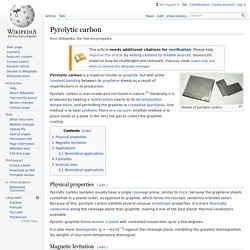
Pyrolytic carbon is man-made and not found in nature.[1] Generally it is produced by heating a hydrocarbon nearly to its decomposition temperature, and permitting the graphite to crystallise (pyrolysis). One method is to heat synthetic fibers in a vacuum. Another method is to place seeds or a plate in the very hot gas to collect the graphite coating. Physical properties[edit] Pyrolitic graphite forms mosaic crystals with controlled mosaicities up to a few degrees. It is also more diamagnetic (χ = −4×10−4) against the cleavage plane, exhibiting the greatest diamagnetism (by weight) of any room-temperature diamagnet. Magnetic levitation[edit] Pyrolytic carbon levitating over permanent magnets Few materials can be made to magnetically levitate stably above the magnetic field from a permanent magnet. [edit] Graphene. Coilgun. A coilgun (or Gauss rifle, in reference to Carl Friedrich Gauss, who formulated mathematical descriptions of the magnetic effect used by magnetic accelerators) is a type of projectile accelerator consisting of one or more coils used as electromagnets in the configuration of a linear motor that accelerate a ferromagnetic or conducting projectile to high velocity.[1] In almost all coilgun configurations, the coils and the gun barrel are arranged on a common axis.
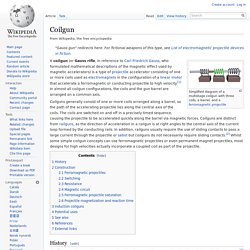
Coilguns generally consist of one or more coils arranged along a barrel, so the path of the accelerating projectile lies along the central axis of the coils. The coils are switched on and off in a precisely timed sequence, causing the projectile to be accelerated quickly along the barrel via magnetic forces. Coilguns are distinct from railguns, as the direction of acceleration in a railgun is at right angles to the central axis of the current loop formed by the conducting rails.
History[edit] Construction[edit] Magnetic Levitation Twin Pipe Transport System - High speed maglev train technology patented by James Stokes. Railgun. Railguns are being researched as a weapon with a projectile that would use neither explosives nor propellant, but rather rely on electromagnetic forces to achieve a very high kinetic energy.
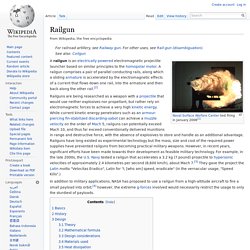
While current kinetic energy penetrators such as an armour-piercing fin-stabilized discarding-sabot can achieve a muzzle velocity on the order of Mach 5, railguns can potentially exceed Mach 10, and thus far exceed conventionally delivered munitions in range and destructive force, with the absence of explosives to store and handle as an additional advantage. Railguns have long existed as experimental technology but the mass, size and cost of the required power supplies have prevented railguns from becoming practical military weapons. However, in recent years, significant efforts have been made towards their development as feasible military technology.
Homopolar generator. Faraday disk, the first homopolar generator A homopolar generator is a DC electrical generator comprising an electrically conductive disc or cylinder rotating in a plane perpendicular to a uniform static magnetic field.
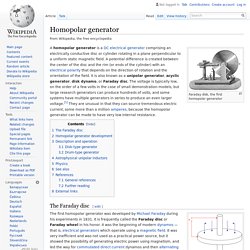
A potential difference is created between the center of the disc and the rim (or ends of the cylinder) with an electrical polarity that depends on the direction of rotation and the orientation of the field. It is also known as a unipolar generator, acyclic generator, disk dynamo, or Faraday disc. The voltage is typically low, on the order of a few volts in the case of small demonstration models, but large research generators can produce hundreds of volts, and some systems have multiple generators in series to produce an even larger voltage.[1] They are unusual in that they can source tremendous electric current, some more than a million amperes, because the homopolar generator can be made to have very low internal resistance. Linear motor. Free-body diagram of a U-channel synchronous linear motor.
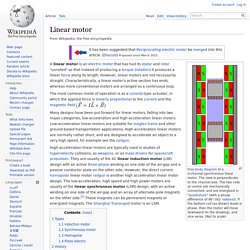
The view is perpendicular to the channel axis. The two coils at centre are mechanically connected, and are energized in "quadrature" (with a phase difference of 90° (π/2 radians)). If the bottom coil (as shown) leads in phase, then the motor will move downward (in the drawing), and vice versa. (Not to scale) The most common mode of operation is as a Lorentz-type actuator, in which the applied force is linearly proportional to the current and the magnetic field Many designs have been put forward for linear motors, falling into two major categories, low-acceleration and high-acceleration linear motors. High-acceleration linear motors are typically used in studies of hypervelocity collisions, as weapons, or as mass drivers for spacecraft propulsion. Types[edit] Lorentz force. In physics, particularly electromagnetism, the Lorentz force is the combination of electric and magnetic force on a point charge due to electromagnetic fields.
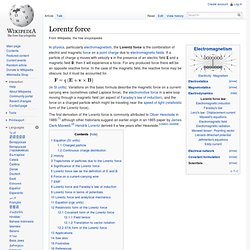
If a particle of charge q moves with velocity v in the presence of an electric field E and a magnetic field B, then it will experience a force. For any produced force there will be an opposite reactive force. Magnets and Electromagnets. Ferromagnetism. Magnets and Electromagnets. Forces between currents. Forces between currents. IMT R 22.